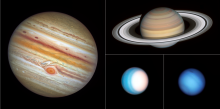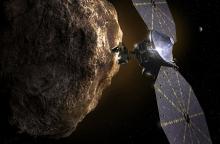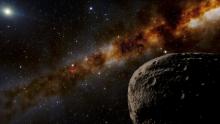You are here
The Solar System: Home Sweet Home
In the winter of 1504, astronomer Nicolaus Copernicus watched as the planets Mars, Jupiter, and Saturn grouped close together in the evening sky. As he tracked them from night to night, he was troubled, because the planets bunched closest to each other about 10 days later than predicted by reference tables of planetary motions.
The tables, compiled centuries earlier, presumed that Earth was the center of the universe, with the Sun, Moon, planets, and stars all orbiting our planet in complex patterns. As Copernicus tried to decipher why the tables were wrong, he discovered that it was more than just a case of faulty numbers: The perceived layout of the universe was wrong. Copernicus realized that Earth and the other planets orbit the Sun, the Moon orbits Earth, and the "fixed" stars are all far, far away.
Copernicus started a revolution in human understanding of the solar system and Earth's place in it. The revolution continued with the invention of the telescope, which allowed astronomers to discover new planets and to find that most of the planets have their own moons. Today, scientific instruments attached to the telescope are allowing astronomers to learn what these worlds are like, and spacecraft are providing close-up views.
All of these discoveries show that even though Earth is not at the center of the universe, it belongs to a remarkable celestial neighborhood. Our planetary neighbors range from small chunks of ice or rock to giant balls of gas, with features ranging from canyons long enough to span the United States to storm systems big enough to swallow Earth. Their moons show even greater diversity, with smog-topped atmospheres, geysers of ice, hidden oceans of liquid water, and pools of liquid sulfur. And rocky and icy "leftovers" from the birth of the planets both penetrate and surround the solar system, adding billions more bodies for us to study.
Despite the rapid advances in knowledge over the last few centuries, there's still much for scientists to discover. They are trying to discern the exact structures of the giant outer planets, for example, and to learn how many planet-sized bodies orbit the Sun far beyond the realm of the known worlds.
Improved technology will help answer many of these questions. Bigger telescopes on the ground and in space will provide ever-sharper views of the solar system, and will allow astronomers to see objects that are much fainter and farther away. New robotic probes will fly past planets, moons, comets, and asteroids, while others will land, roam around the surfaces of these remote worlds, and even bring samples back to Earth for more detailed study.
Eventually, humans may see these worlds from close range. Whether it's from up close or from right here on Earth, though, scientists will learn more about our neighboring worlds as they continue the revolution that Copernicus began by moving Earth out of the center of the universe and into a remarkable neighborhood: the solar system.
Keywords
Teacher Copies
Request a free copy of The Solar System or Beyond the Solar System for your classroom. Bulk copies are available for $1.50 each in quantities of 30 or more. Shipping is included. Call 512-471-5285 for orders of 30 or more.
 The Astro Guides for the Solar System and Beyond the Solar System are supported by the National Aeronautics and Space Administration under Grant Nos. NNG04G131G and NAG5-13147, respectively.
The Astro Guides for the Solar System and Beyond the Solar System are supported by the National Aeronautics and Space Administration under Grant Nos. NNG04G131G and NAG5-13147, respectively.





